My Musical Career Part Twenty-One
The Evansville Years – Part Three
Owensboro
The other major part of the consortium position was that of timpanist of the Owensboro Symphony Orchestra. Owensboro, Kentucky is located about forty miles east of Evansville, on the west bank of the Ohio River. Home to Brescia College and several other respected institutions of higher learning, Owensboro in 1980 (as it remains today) had an active artistic community, and the Owensboro Symphony was one of its centerpieces. At the time, the orchestra had as its music director Leon Gregorian, who took up that position in 1971 and remained as music director until 1985, about two years after I left for Oslo, Norway. He was about forty years of age when I first new him, and he was a most interesting individual. I believe he was of Armenian descent, but was born in Tehran (my memory is a little off in this regard), but Leon was a musician who would make an immediate impression on one. He was warm-hearted, down-to-earth and enthusiastic. He was a musician of great skill and had an excellent rehearsal technique. He could rehearse an orchestra, and if need be, that orchestra would be able to give a concert after only one rehearsal. Not many conductors have that ability. But Leon did, and it enabled him to program works for the orchestra that other conductors might have shied away from. I enjoyed working with him from day one, and one of my regrets is that I have not been able to visit with him since I left for Norway in 1983.
The orchestra was roughly the same size as the Evansville Philharmonic, and was made up of a contingent of Evansville players, of whom I was one; local professionals from Owensboro and the surrounding areas; and a contingent of Indiana University students who were bussed down from Bloomington for each concert series. (The Evansville Philharmonic also filled out its ranks in similar fashion.)
Rehearsals were held on Sundays from 2 to 5 pm and 7:30 to 10 pm at the orchestra’s headquarters in a converted fire station near the downtown area. There were offices for the staff and a large rehearsal room which would just about accommodate the orchestra.
On Friday evening, and on Saturday morning, we would rehearse at the Daviess County High School auditorium a few miles out of town; this was also the venue for our concerts. I remember the acoustic as being rather dry, and it really looked like a high school auditorium from the sixties and seventies. This was before the era of constructing high school facilities with so-called “performing arts centers”.
Leon’s wife Linda was the concertmaster during my time in Owensboro. Most of the principal musicians were from Evansville – Greg Olsen on bass; David Wight on clarinet; Ed Lacy on bassoon; Peter Moore on horn (at least that first season); Jim Bursen on trumpet; Bill Bootz on trombone. Principal percussion for my first season was Tom Van Arsdale, my competitor for the consortium position, and who was the percussion instructor at Murray State University in Paducah. These are the folks I remember from my time there – there were some changes during the three years I held the position, but for the most part many of these folks held these positions throughout my tenure.
Tom was great to work with, very helpful and a skilled percussionist. I enjoyed working with him, and remember some good concerts that we played – including an exciting Beethoven Ninth Symphony; a performance that included Richard
Strauss’s Don Juan and the 1911 version of Stravinsky’s Petrouchka.
Another important performance of that first season was a program that included music of Johann Strauss II and Richard Strauss. Divided into two halves, the concert opened with the music of Richard Strauss – his Festival Week Prelude, followed by a performance of his Burleske, for piano and orchestra. The Burleske opens with a solo statement on four timpani, which is repeated after a short orchestral outburst and then repeated. It is a fun part and despite having to play it on the Ludwig Dresdens, it went well. As I may or may not have mentioned earlier, the Ludwig Dresdens owned by the Owensboro Symphony were somehow less stiff in operation than the Evansville drums (which, ironically were newer) and had better heads on them – at least they had a fuller and rounder sound. That is how it appeared to me at the time. I always enjoyed playing on the OSO’s timpani. The second half of the concert was more like a “New Year’s Concert” in that it was devoted to the waltzes and polkas of Johann Strauss II. I hoped that I would have another crack at the Burleske later in my career, but nearly 34 years later, it still hasn’t happened.
Owensboro Highlights
Percussion personnel changed during my second and final years with the OSO. Tom Van Arsdale chose to devote his time to his Murray State University position, and as a result did not return to the OSO for my last two years. Dave Sander, who filled the principal percussionist’s position in Evansville helped out in my last two seasons, as did my students Jay, Becca and A.J. (who also filled out the percussion section in the EPO), although only sporadically as there were local and IU students helping out in OSO.
Orchestral highlights of my last two seasons included an incandescent performance of the Verdi Requiem; a blazingly intense performance of Respighi’s Festa Romanae; an equally vivid account of the Dvorak “New World” Symphony, in which Leon suggested an alteration to the very end of the symphony, which enhanced it in a very exciting manner. For those interested, near the very end of the final movement, the tutti orchestra makes a unison statement of the first two bars of the main theme of the finale, with the last two bars being underpinned harmonically. On that the third bar, instead of playing an e, which is written, Leon had me change that one bar to a d instead, which makes more sense harmonically and dramatically – especially when it leads right back to the e-minor closing. I thought it worked well then and remembered it over the years, playing it during a BBC Proms performance at the Royal Albert Hall in 1996 under Manfred Honeck. I remember the Controller of the BBC program coming up to me at the post-concert reception, score in hand and saying – “This isn’t in the score!” I agreed, and pointed out that it was harmonically and dramatically justified. He thought about it for a minute and ended up agreeing with me and said “Actually, it was most effective”.
Other Owensboro memories include a run-out concert – an overnight trip – to Bowling Green, Kentucky where we played an outdoor concert. We got down there about 6:00 in the evening, and were supposed to do a rehearsal under lights on the outdoor platform that evening, with a warm-up rehearsal and concert the next day. However, the place was so full of gnats that Leon cancelled the rehearsal and we had the evening to ourselves and did a full rehearsal and concert the next day – when the platform was gnat-free. It was a fun concert – typical outdoor fare, but we enjoyed ourselves.
Evansville Highlights
The Evansville Philharmonic performed some memorable programs during this same period. Both orchestras scheduled their seasons around each other – there was none of this rehearsal/concert conflict so prevalent today, so we were kept uniformly busy. The reason that they could do this is that they by and large used the same sets of core principals and Indiana University students, so it was a no-brainer from that stand-point.
The percussion section in the EPO was made up of myself on timpani, David Sander as principal percussion, with two or three of my students filling out the section as needed. If a large section was needed, a couple of IU students filled it out.
As I mentioned earlier, the timpani that I used in Evansville was a newer set of Ludwig Dresdens. I learned rapidly that newer does not necessarily mean better. The mechanism was stiffer than the Owensboro drums, and the heads did not ring as much. Nonetheless, they were still a lot better than the Slingerlands and the old Ludwigs that I used in Albany.
I mentioned earlier that the opening concert of my first season included the “Carnival” overture of Dvorak, which is such an exuberant piece of music. It was a good way to start my tenure; also on the program was the Second Symphony of Johannes Brahms, which was then and is now one of my favorite pieces of music. The finale is a particular favorite movement of mine, and I particularly enjoy playing the coda. That performance under Stewart Kershaw was a highly charged one.
Other works that season included the Tchaikovsky 5th Symphony, also in a very emotionally charged performance, along with Elgar’s “Cockaigne” Overture and Chopin’s Piano Concerto No.2. The closing performance of my first season included a performance of Schumann’s “Spring” Symphony, a performance of the Liszt Piano Concerto No. 1, and Stravinsky’s Firebird Suite, in the revised version.
During my second season, my personal life changed in that I got married in August of 1981, and my wife joined the Philharmonic Chorus. She sang in several productions in which the chorus collaborated with the orchestra: Verdi’s Te Deum, a marvelous piece of music, and the Second Suite from Ravel’s ballet “Daphnis et Chloe”. There was a also a “Messiah”, Part One, and a Christmas concert. In Evansville, these were called “Peppermint Pops”, and were very popular with the public. Another highlight of that second season was a performance of Frank Martin’s Concerto for Seven Wind Instruments, Timpani, Percussion and String Orchestra. It was a challenge using those stiff Dresden’s as they never quite landed on the proper pitch – they required constant fine tuning adjustments throughout, and yet I managed well enough.
During the second season, Stewart Kershaw had to take a few concerts off due to a bad back, and he was replaced by a conductor from the Cincinnati Ballet called Carmon de Leone. He was about fortyish at the time, and this was about three or four years before he became conductor of the Illinois Philharmonic. He was extremely talented, and very demanding. He had (and has) a very good ear and a very business-like rehearsal technique. He conducted two concerts with us during Stewart’s absence. One included music of Richard Strauss: his Horn Concerto No. 1 and his tone poem “Til Eulenspiegel”. The other was a pops concert featuring Dr.Peter Schickele – otherwise known for his PDQ Bach persona. It was an excellent concert – it began with Schickele’s assistant appearing before the assembled audience and orchestra and looking at his watch, announcing that since the good doctor had not shown up for the performance, the concert was being cancelled and the patron’s tickets would be refunded. Just as everybody was getting up to leave, a voice from above called out “Wait a minute! I’m here!”, and from the side of the auditorium, Dr. Schickele slid down a rope and onto the stage, and the evening’s festivities commenced. We played his Suite from the Sevilian Barber; Concerto for Piano vs Orchestra, and other Schickele specialties. The second half of the concert began with auditorium completely darkened and Dr. Schickele made his entrance, deliberately falling over a pile of strategically placed music stands, which was a riot. I’ll remember that concert for a long time. Another concert that I remember well was from my first season, and was conducted by Margaret Hillis, then the world-renowned director of the Chicago Symphony Chorus and music director of the Elgin Symphony. The program included Richard Strauss’ “Vier Letzte Lieder” and Mendelssohn’s “Italian Symphony”. It was fine program, and several of us musicians got a chance to visit with Margaret at a reception in her honor after the concert. She was a fine musician, and quite a conversationalist. All in all, both orchestras kept me musically challenged during my tenure.
NB! The picture of me in rehearsal was taken at a rehearsal of Stravinsky’s Petrouchka – 1911 version – I was using my Feldman softs during a soft passage – the note was G sharp.

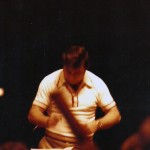
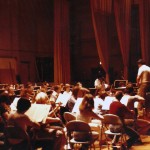
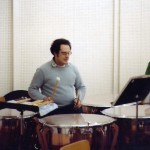
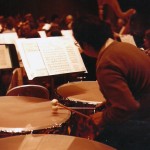
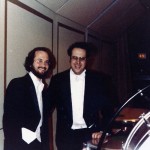
Recent Comments